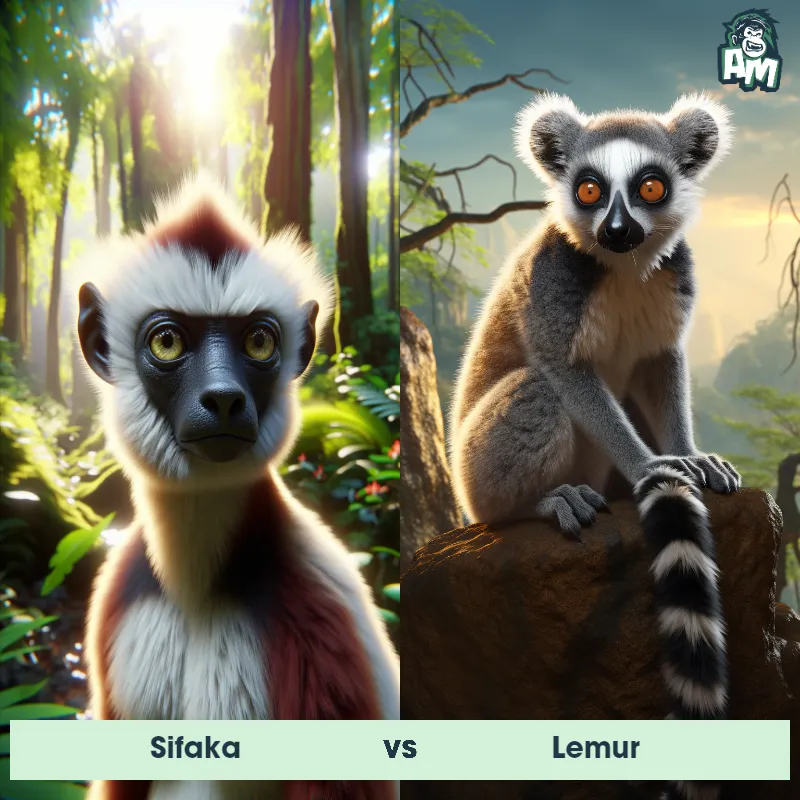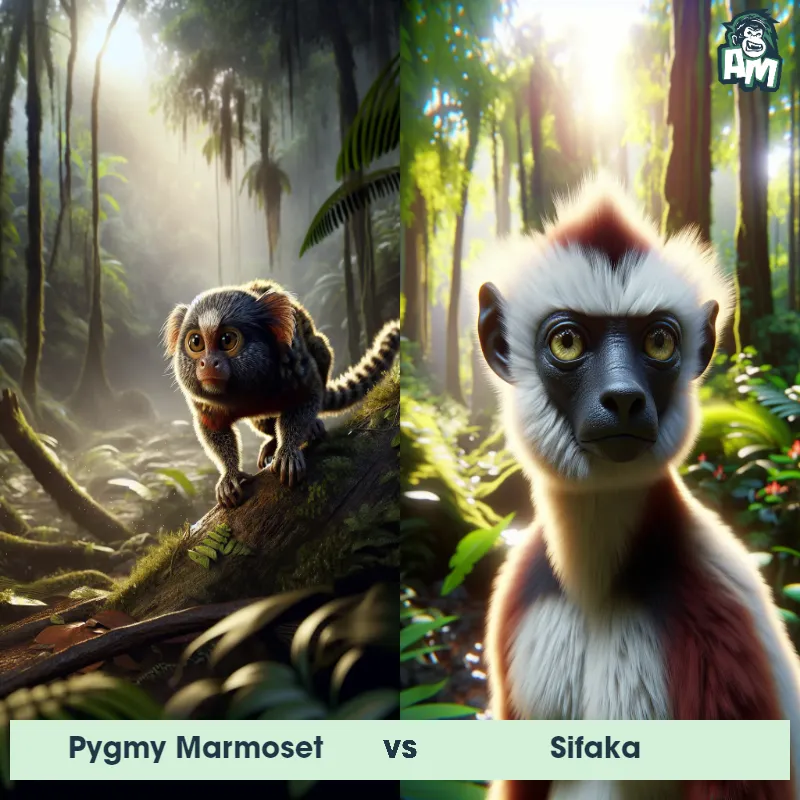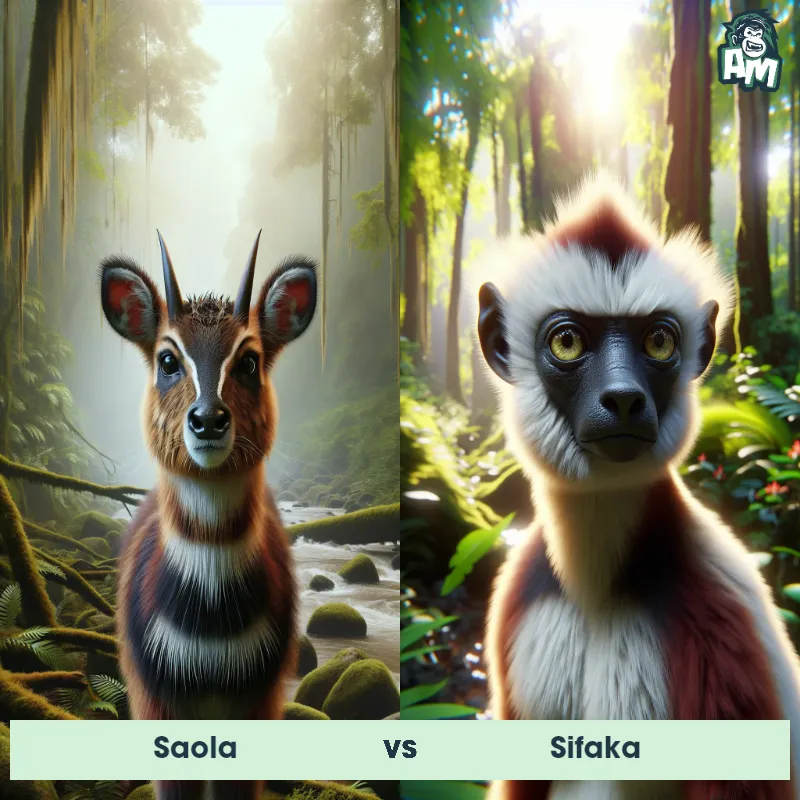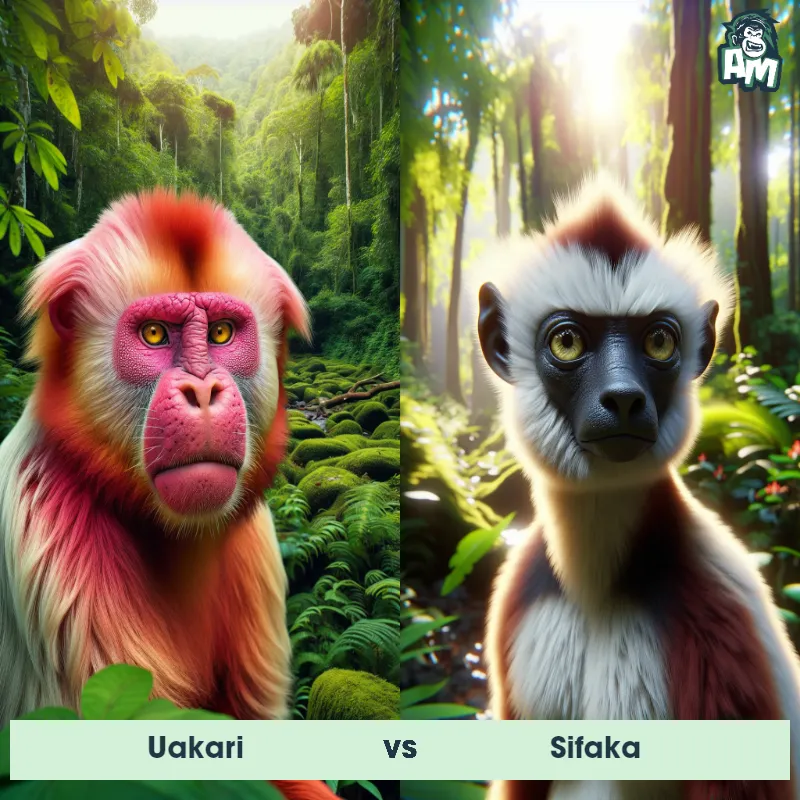The Sifaka
The Sifaka, also known as the Coquerel's sifaka, is a lemur native to the island of Madagascar. These primates are known for their unique way of moving, as they have long limbs and a specialized skeletal structure that allows them to perform vertical leaping. They have a white fluffy coat with a dark face and expressive eyes. Sifakas have a prehensile tail that they use for balance while leaping, and they communicate with each other through a series of vocalizations and scent marking.

| Sifaka | |
|---|---|
| Size | 18-22 inches (45-55 cm) |
| Weight | 6-8 pounds (2.7-3.6 kg) |
| Speed | 20mph (32km/h) |
| Key Strength | Agility and leaping ability |
| Biggest Weakness | Lack of physical aggression |
| Scientific Name | Propithecus coquereli |
| Family | Indriidae |
| Habitat | Forests, specifically dry deciduous forests and mangroves |
| Geography | Found in Madagascar |
| Diet | Primarily leaves, fruits, and flowers, occasionally supplemented with seeds, bark, or soil |
| Lifespan | 15 years - 20 years |

The Sifaka
The Sifaka, also known as the Coquerel's sifaka, is a lemur native to the island of Madagascar. These primates are known for their unique way of moving, as they have long limbs and a specialized skeletal structure that allows them to perform vertical leaping. They have a white fluffy coat with a dark face and expressive eyes. Sifakas have a prehensile tail that they use for balance while leaping, and they communicate with each other through a series of vocalizations and scent marking.
Fun Fact: The Sifaka is famous for its distinctive method of locomotion called "vertical clinging and leaping," in which they bound through the trees by pushing off with their powerful hind limbs and extending their long limbs horizontally to cover great distances, easily reaching up to 32 feet in a single leap.
| Sifaka | |
|---|---|
| Size | 18-22 inches (45-55 cm) |
| Weight | 6-8 pounds (2.7-3.6 kg) |
| Speed | 20mph (32km/h) |
| Key Strength | Agility and leaping ability |
| Biggest Weakness | Lack of physical aggression |
| Scientific Name | Propithecus coquereli |
| Family | Indriidae |
| Habitat | Forests, specifically dry deciduous forests and mangroves |
| Geography | Found in Madagascar |
| Diet | Primarily leaves, fruits, and flowers, occasionally supplemented with seeds, bark, or soil |
| Lifespan | 15 years - 20 years |
Sifaka Matchups
We use AI to simulate matchups between the Sifaka and other animals. Our simulation considers size, strength, and natural predatory behaviors to determine the most likely outcome.

Can't find the Matchup you want?
Create Your Own MatchupSifaka: Diet, Predators, Aggression, and Defensive Behaviors
What do Sifakas eat?
Sifakas are primarily herbivores, with their diet consisting mainly of leaves, fruits, flowers, and seeds. They are known to feed on a variety of plant species, including young leaves, bark, and sap from trees.
Do Sifakas have any predators?
Sifakas are preyed upon by various predators in their natural habitat, including fossas, hawks, boa constrictors, and humans. Fossas, in particular, are skilled hunters that pose a significant threat to Sifakas.
Are Sifakas aggressive?
Sifakas are generally not aggressive animals. They are known for their gentle and peaceful nature within their social groups. However, they may display territorial behavior towards other groups or individuals encroaching on their territory.
Do Sifakas fight?
While Sifakas tend to avoid conflicts, they may engage in fights with rival groups over territorial disputes or mating rights. When fights occur, they often involve vocalizations, displays of aggression, and physical confrontations, such as chasing and physical attacks.
How do Sifakas defend themselves?
Sifakas have several defense mechanisms to protect themselves from predators and other threats. They are agile climbers and leapers, allowing them to escape quickly into trees when threatened. They also use alarm calls to alert group members of danger and may rely on their social structure to provide protection against predators.
What is Sifakas' biggest weakness in a fight?
One of Sifakas' biggest weaknesses in a fight is their relatively small size and lightweight bodies. While they are fast and agile, they may struggle to defend themselves against larger predators or aggressive individuals. Their lack of physical strength compared to some predators can make them vulnerable in confrontations.
Fun Fact: Sifakas have a unique strategy for thermoregulation, as they sunbathe in order to warm up their bodies and increase their energy levels, and they often raise their arms and legs to expose their white fur to the sun, providing a striking visual display.
Fun Fact: Sifakas are highly adapted to arboreal life and spend most of their time in trees, but they are also extremely agile on the ground due to their long legs, enabling them to travel on the forest floor with a sideways hopping gait, making them one of the few lemurs that can effectively move on the ground.














